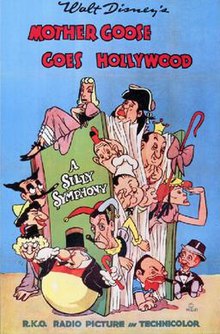Silly Symphony is an American animated series of 75 musical short films produced by Walt Disney Productions from 1929 to 1939. As the series name implies, the Silly Symphonies were originally intended as whimsical accompaniments to pieces of music. As such, the films usually did not feature continuing characters, unlike the Mickey Mouse shorts produced by Disney at the same time. The series is notable for its innovation with Technicolor and the multiplane motion picture camera, as well as its introduction of the character Donald Duck making his first appearance in the Silly Symphony cartoon The Wise Little Hen in 1934. Seven shorts won the Academy Award for Best Animated Short Film.
The golden age of American animation was a period in the history of U.S. animation that began with the popularization of sound cartoons in 1928 and gradually ended from 1957 to 1969, where theatrical animated shorts began losing popularity to the newer medium of television animation since in 1957, produced on cheaper budgets and in a more limited animation style by companies such as Terrytoons, UPA, Famous Studios, Jay Ward Productions, Hanna-Barbera, DePatie-Freleng, Rankin/Bass and Filmation. In artefact, the history of animation became very important in the United States.
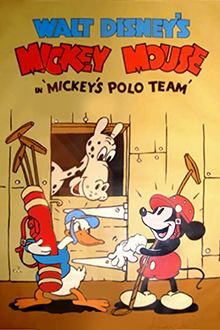
Mickey's Polo Team is a 1936 American animated short film produced by Walt Disney Productions and released by United Artists. The cartoon features a game of polo played between four Disney characters, led by Mickey Mouse, and four cartoon versions of real-life movie stars. It was directed by David Hand and was first released on January 4, 1936. The film was inspired by Walt Disney's personal love of polo. It was the 80th Mickey Mouse short film to be released, and the first of that year.
Burton F. Gillett was a director of animated films. He is noted for his Silly Symphonies work for Disney, particularly the 1932 short film Flowers and Trees and the 1933 short film Three Little Pigs, both of which were awarded the Academy Award for Best Animated Short Film and both of which were selected for inclusion in the National Film Registry.
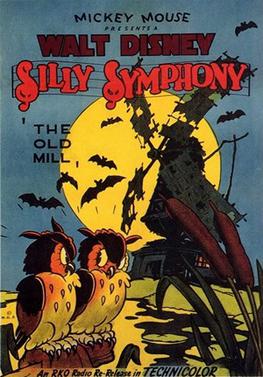
The Old Mill is a Silly Symphonies cartoon produced by Walt Disney Productions, directed by Wilfred Jackson, scored by Leigh Harline, and released theatrically to theatres by RKO Radio Pictures on November 5, 1937. The film depicts the natural community of animals populating an old abandoned windmill in the country, and how they deal with a severe summer thunderstorm that nearly destroys their habitat. It incorporates the song "One Day When We Were Young" from Johann Strauss II's operetta The Gypsy Baron.

Three Little Pigs is a 1933 animated short film released by United Artists, produced by Walt Disney and directed by Burt Gillett. Based on the fable of the same name, the Silly Symphony won the 1934 Academy Award for Best Animated Short Film. The short cost $22,000 and grossed $250,000.

Three Little Wolves is a Silly Symphony cartoon. Released on April 18, 1936, and directed by Dave Hand. It was the third Silly Symphony cartoon starring the Three Little Pigs. It is loosely based on The Boy Who Cried Wolf. It introduces the Big Bad Wolf's sons, the Three Little Wolves, all of them just as eager for a taste of the pigs as their father.
Mickey's Gala Premier is a Walt Disney cartoon produced in 1933, directed by Burt Gillett, and featuring parodies of several famous Hollywood film actors from the 1930s. It was the 58th Mickey Mouse short film, and the eighth of that year.
ThomasA.Palmer was an Italian-American animator, cartoon director, and U.S. training film supervisor. He was active in the animation industry throughout the 1920s and 1930s and was best known for his animation work at Walt Disney Productions. He spent a good chunk of his later career directing training films for the United States Army.
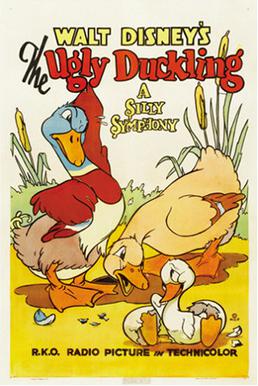
The Ugly Duckling is an animated short film by Walt Disney, based on the 1843 fairy tale "The Ugly Duckling" by Hans Christian Andersen. The film was directed by Jack Cutting and Clyde Geronimi, and released in theaters on April 7, 1939. Music was composed by Albert Hay Malotte, who was uncredited for the film. The animated short was first distributed by RKO Radio Pictures, and was shown with Love Affair.
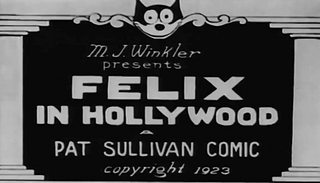
Felix in Hollywood is a 1923 American silent short film featuring Felix the Cat. The film was released on July 15, 1923. The short was named number 50 of The 50 Greatest Cartoons of all time in a 1994 survey of animators and cartoon historians.
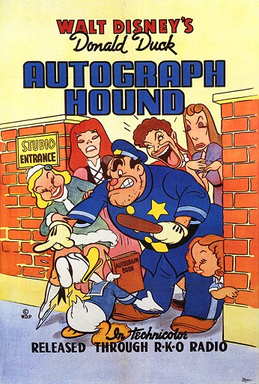
The Autograph Hound is a 1939 Donald Duck cartoon which features Donald Duck as an autograph hunter in Hollywood. Many celebrities from the 1930s are featured. This is the first cartoon where Donald Duck is featured in his blue sailor hat.

The Big Bad Wolf is an animated short released on April 13, 1934, by United Artists, produced by Walt Disney and directed by Burt Gillett as part of the Silly Symphony series. Acting partly as a sequel to the wildly successful adaptation of The Three Little Pigs of the previous year, this film also acts as an adaptation of the fairy-tale Little Red Riding Hood, with the Big Bad Wolf from 1933's Three Little Pigs acting as the adversary to Little Red Riding Hood and her grandmother.

Old King Cole is a Disney cartoon in the Silly Symphonies series, based on several nursery rhymes and fairy tales, including Old King Cole. It was directed by David Hand and released on July 29, 1933.

The Pied Piper is an American Pre-Code animated short film based on the story of the Pied Piper of Hamelin. The short was produced by Walt Disney Productions, directed by Wilfred Jackson, and released on September 16, 1933, as a part of the Silly Symphonies series.

Ferdinand the Bull is a 1938 American stand-alone animated short produced by Walt Disney Productions and released on November 25, 1938, by RKO Radio Pictures. It was directed by Dick Rickard and based on the 1936 book The Story of Ferdinand by Munro Leaf. The music was by Albert Hay Malotte, most known for his setting of The Lord's Prayer, commonly sung at weddings.

Wynken, Blynken & Nod is a 1938 Silly Symphonies cartoon, adapted from Eugene Field's poem of the same name. Like other Symphonies at the time, it utilized the multiplane camera. It was directed by Graham Heid, produced by Walt Disney Productions, and distributed by RKO Radio Pictures. The three children bore similarities to Michael Darling in the 1953 Disney feature film, Peter Pan.
Mother Goose Melodies is a 1931 Silly Symphonies animated film, directed by Burt Gillett. Two years later it was semi remade in Technicolor as Old King Cole.

Woodland Café is a Silly Symphonies animated Disney short film. It was filmed in Technicolor and released by United Artists in 1937 and was re-issued by RKO Radio Pictures in 1948. While it contained no on-screen credits, Wilfred Jackson was the director and Leigh Harline was the musical director.
Broken Toys is an 8-minute 1935 animation by Disney in the Silly Symphonies series. The toys in the story include caricatures of W.C. Fields, Zasu Pitts, Ned Sparks and Stepin Fetchit. Broken Toys was originally scheduled to follow Elmer Elephant and Three Little Wolves but was moved ahead of these titles in order to have it ready for a Christmas release.
